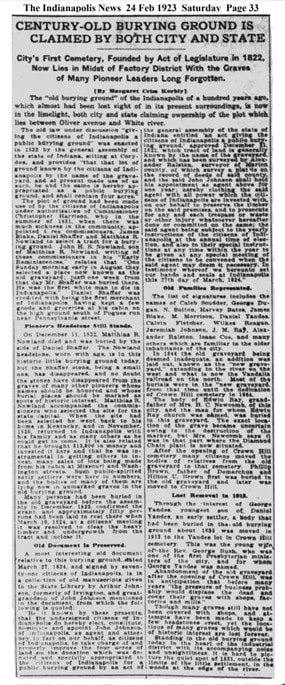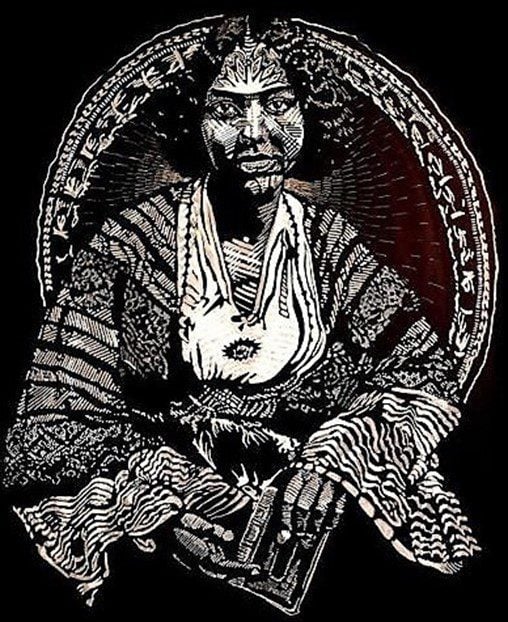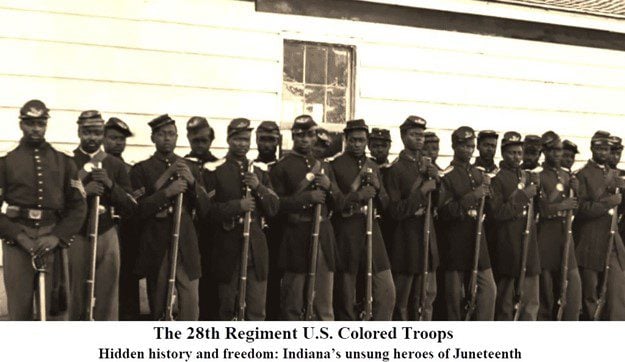
In a nearly forgotten area along the banks of the White River in downtown Indianapolis lay buried gems of the past. These gems are the human remains of notable leaders who lived extraordinary lives, including the first Black landowner in Indiana — who is a woman, Muhammad Ali’s great-great grandfather, the first Black Grand Master Mason of the Most Worshipful Prince Hall Grand Lodge, a jazz musician, a doctor, the man who inspired Harriett Beecher Stowe’s UNCLE TOM’S CABIN, a Civil War hero*, barbers, and other significant leaders of the Black community in the early to mid-1800s. Many of those buried were born enslaved, then freed, and were quite accomplished in their lifetimes.
Greenlawn Cemetery opened in 1821 and closed to new burials in 1890, when, according to city records, the cemetery was full. Many of the inhabitants of Greenlawn Cemetery lived along Indiana Avenue, which served as the cradle for economic and social prosperity for African Americans from the late 1700s until the Indianapolis city council razed their affluent neighborhood for a new highway system, thanks to the passage of the 1956 Federal-Aid Highway Act during the Eisenhower administration. Not only was Indiana Avenue a business hub, but it also served as an important arts and culture district. Today, the final resting place of many of those who built up the Indiana Avenue corridor will likely be literally paved over for more development: the Henry St. bridge project and a new development by the Keystone Group, which includes a professional sports stadium for the Indy Eleven.
The headline of an article in The Indianapolis News 24 Feb 1923 reads, “CENTURY-OLD BURYING GROUND IS CLAIMED BY BOTH CITY AND STATE, City’s first Cemetery, Founded by Act of Legislature in 1822, Now Lies in Midst of Factory District With the Graves of Many Pioneer Leaders Long Forgotten.” The first paragraph reads, “The “old burying ground” of the Indianapolis of a hundred years ago, which almost had been lost sight of in its present surroundings, is now in the limelight, both city and state claiming ownership of the plot which lies between Oliver Avenue and White River.”

This article highlights the losing battle of maintaining the cemetery grounds with the influx of industry. Marion County Surveyor Alexander Ralston (who would eventually be buried at Greenlawn Cemetery, see his name mentioned below with Chaney Lively) platted the area. Pioneers such as Daniel Shaffer, the first merchant of Indianapolis, was the first white man to die and be buried in Indianapolis. Mr. Shaffer sold “goods and groceries from his cabin on the high ground south of Pogues run near Pennsylvania street“. Daniel Nowland, another early pioneer, was buried beside Mr. Shaffer. Nowland helped select the site of the State Capital and both of their gravesites were unmarked. An old document from 27 March 1824 is referenced to having been signed by seventy citizens of Indianapolis to establish the public burial ground known as Greenlawn, with Calvin Fletcher’s signature among them. By 1844, Greenlawn was filling up fast and deemed inadequate. As a result, Crown Hill Cemetery opened. Those who could afford to relocate their loved ones, did so, leaving many of the early settlers’ gravesites behind only to be paved over by the Diamond Chain plant.
The last paragraph of the 1923 article reads: Though many graves still have not been covered with shops, and attempts have been made to keep a few headstones erect, yet the locations of many graves which would be of historic interest are lost forever. Standing in the old burying ground today is the heart of the industrial district with its accompanying noise and unsightliness. It is hard to picture the quiet spot of 1821, outside the limits of the little settlement, in the woods at the edge of the river.
It seems that history is repeating itself exactly 100 years later. Current city officials have stated that they would like to “make an example” of the Henry St. bridge project. A consensus of what an appropriate course of action looks like remains unknown, and their intended vision of what a positive “example” looks like is yet to materialize.
Eunice Trotter, Director of the Black Heritage Preservation Program with Indiana Landmarks initiated the research of African American burials at Greenlawn Cemetery with the help of one of her interns, Ahmaud Carroll-Tubbs, who discovered Morris Greathouse’s connection to Muhammad Ali. Carroll-Tubbs also extracted all of the Black burials from the Marion County Mortality Schedules, which is the list historians and genealogists are now using in their research. Trotter enlisted the help of Historian Leon Bates, adding Bates to an advisory group including members of the Marion County Historical Society, the Indiana Remembrance Coalition, The Indiana African American Genealogy Group (IAAGG), and the Caroline Scott Harrison Chapter of DAR (Daughters of the American Revolution, whose side hustle is genealogy). Essentially, Trotter assembled The Avengers.
Earlier this year, Indiana Landmarks funded a Ground Penetrating Radar (GPR) Investigation of a 20 x 20 meter portion of Greenlawn Cemetery by Stantec, Inc. The report was released last month. The results presented more questions than answers, with the conclusion that “the only way to definitively identify possible graves in the area would involve systematic mechanical stripping with an archaeologist present to monitor the excavation.”
Currently, a Herculean effort is underway by a team of genealogists to identify and trace the ancestry of those buried at Greenlawn Cemetery during the decade spanning 1871 – 1882. It is known that 1,300 people of color were buried at Greenlawn Cemetery during this time.
The genealogists that Trotter enlisted include Duane D. Perry, Andrea Price, Victor Stuart, Pam Griffin, Pamella Lomax, Marva Crews, Doris Fields, and Denise Chisley. All are members of the IAAGG. The motto of the IAAGG is “Researching our past to preserve our legacy.”
“Doing the research is one of the most rewarding things that I have done,” shares Duane D. Perry, the team leader of the genealogists bringing these long-lost stories to life. “I now know these people, and this part is really special.”
Much of the information on these historically significant lives mentioned below is taken directly from notations made by Duane D. Perry and his team, with little editing.
Leaders and legacies
The first Black landowner in Indiana was a woman: Chaney Lively. She was born enslaved in 1795, yet when she was “purchased” likely in Louisville by a man named Alexander Ralston, a life-long bachelor. He brought Chaney to Indianapolis in 1821 as a “domestic” worker, and she was not enslaved by this time. Ralston is a surveyor who was hired by the City of Indianapolis. He worked on the survey of Indianapolis through the summer of 1821, and when the platted lots went up for sale, he purchased two, one for himself, and the other for Chaney. This made her the first Black landowner in Indiana. There is a great deal of documentation of Chaney Lively’s life, more so than any other Black woman during this time. This is remarkable considering she lived at a time when almost no Black women were named in censuses, being either the property of or live-in employees of white people, or the unnamed wives or daughters of free Black men. Chaney was a well-respected person, and she married John G. Britton in 1836. Britton was a local barber and community leader with a four-year old daughter, Eliza Jane Britton, who is also buried in Greenlawn Cemetery. Britton was involved in the Negro Convention movement, and in 1856, fellow Black Masons elected him the first Grand Master of the Most Worshipful Prince Hall Grand Lodge in Indianapolis (1856 – 1859). The Prince Hall Lodge in Richmond is named Britton Lodge in honor of John Britton. In Indianapolis, Britton was a member and trustee of the Second Baptist Church. The Brittons did not have any children together. Chaney Lively died in 1857 or 1858 of unknown causes. Britton married twice more and died in 1885 of complications from gangrene.

John Britton was 25 years old when his daughter Eliza Jane Britton (Gibbs) was born in 1833 in Indiana. Chaney Lively would become her stepmother three years later when Chaney was 33. She married Reuben Gibbs on March 27, 1851, in Marion, Indiana. Eliza J. Britton’s mother is unknown but was raised by Chaney Lively while married to her father in his first marriage. Ida M. Britton, her sister came during her father’s second marriage to Mary A. Dines. Eliza later married Reuben Gibbs (27 Mar 1851) in Indianapolis or Marion, IN. They had a daughter a year later (1852) Cora Lee Gibbs and then a son, Marcus Gibbs in 1854. A third child, named, George Isaac Temple was born on April 29, 1900, After Eliza’s death. Eliza died on September 9, 1872, in Indianapolis, Indiana, at the age of 39, and was buried there. George Isaac Temple, a jazz musician who later worked as an advertising account manager for the Indianapolis Recorder, was likely Eliza Britton Gibbs’ last living descendent in the Indianapolis area. Temple married Fredonia Stewart, daughter of Recorder founder George P. Stewart and later co-owner of the paper. George I. Temple died in 1996.
Morrison Greathouse was married to America Greathouse. He was born in 1838 in Kentucky and died of pneumonia in Indianapolis. He is the great-great-grandfather of Cassius Clay (Muhammad Ali). One of his sons was Archie Greathouse (1859 – 1936) who became one of the largest Black property owners in Indianapolis. Archie owned many of the businesses along the historic Indiana Avenue. Archie vehemently opposed the building of Crispus Attucks High School because he did not believe in segregated schools.

Sarah (Sally) Williams was born in 1770 in North Carolina and had one son, Isaac Williams, in 1812. She was 106 when she died on January 3, 1876 in Indianapolis. Sally was buried in Greenlawn Cemetery. The book AUNT SALLY: THE CROSS, THE WAY OF FREEDOM was written about her life. Isaac was a renowned Reverend who settled in Detroit. He was born enslaved and the book begins when Isaac, a young boy, is told the news that his mother was sold to someone in Alabama.

Augustus Turner was born in 1806 in Kentucky to free parents. He moved to Indianapolis in 1833, where Augustus became a barber and was elevated to becoming widely known and highly esteemed as any African American in the state. He lived most of his life in a log cabin he built himself at the corner of Tennessee and 99 W. Georgia Streets. His barber shop was located where now sits Merrill’s bookstore. The first colored Methodist Episcopal church (later to become Bethel A.M.E. — African Methodist Episcopal) was organized in his home. He remained a faithful member of his church and Augustus was also a charter member of the Indiana Grand Lodge of colored Free Masons. Augustus had ten children with Tryphena Grafford Turner between 1835 – 1853. Five of their children died before the age of ten, two sons and three daughters survived. Augustus died on March 29, 1880 in Indianapolis. He was 74. Tryphena Grafford was borm in 1810 in Henderson, Kentucky. She died suddenly, with no medical cause officially recorded, on December 9, 1873, at the approximate age of 62 and was buried in Greenlawn Cemetery. Augustus Turner’s death is well-documented in the newspapers, with people of all colors honoring him and his legacy.

William W. Goff was born in 1845 in Indiana. He enlisted on January 25, 1865 and was discharged on November 8, 1865 from Calvary Battery Unit US Colored Troops Regiment 28. His remains were moved to Crown Hill Cemetery on March 7, 1900, along with his father Samuel Goff. The cause of death for both William and Samuel was consumption. *The government paid for military veterans to be relocated to Crown Hill Cemetery.
Another Greenlawn Cemetery occupant is Tom Magruder, who lived to be 110 years old. There is substantial (circumstantial) evidence that Magruder’s story inspired, at least in part, UNCLE TOM’S CABIN by Harriet Beecher Stowe, published in 1851. While Stowe acknowledged the influence of THE LIFE OF JOSIAH HENSON, FORMERLY A SLAVE, NOW AN INHABITANT OF CANADA, she was also moved by stories of others, and is likely to have been familiar with Magruder, whose cabin was called “Uncle Tom’s Cabin” on the northeast corner of Noble (now College Avenue) and Market Streets.
Honoring hallowed ground
Historian Leon Bates has thoroughly researched the history of Greenlawn Cemetery.
“If I had my way, we would plant grass seed and call it a day, but I am realistic enough to know that this acreage is not going to go undeveloped. So, if we are going to do this, let’s move all of the people left behind [in Greenlawn Cemetery] and develop whatever you want on top of this ground,” states Bates, who is currently working on a PhD in Pan-African Studies. “Just move the people.”
RELATED: Researching his roots: Duane D. Perry, Sr. leverages genealogy to uncover the stories of his family
The African Burial Ground in Manhattan is perhaps the best example of how to address historically significant burial plots. Federally funded construction projects must comply with Section 106 of the National Historic Preservation Act of 1966. A “Stage 1A Cultural Resource Survey” was conducted prior to the construction of a 34-story federal office building along Broadway. An archeological dig discovered human skeletal remains 30 feet below street level. The Burial Ground dates back to the early 17th century and contains the remains of enslaved Africans, whose labor was exploited to build much of the early skyline of New York City.
Per the website dedicated to The African Burial Ground:
Memorialization and research of the enslaved African skeletal remains were negotiated extensively between the General Services Administration, the African American descendant community, historians, archeologists, and anthropologists, including city and state political leaders. Civic engagement led to the ancestral remains’ reinterment within the original site of rediscovery. An outdoor memorial, an interpretive center, and research library were constructed to commemorate the financial and physical contributions of enslaved Africans in colonial New York and honor their memory.
Across the country there are an abundance of examples of the opposite approach, with parking lots and office buildings being built on top of Black gravesites with little to no hesitation. How the city of Indianapolis and the Keystone Group will respond by honoring this sacred ground is yet unknown.
One fact is that history and the preservation of legacies is important.
As part of the financing needed to see this project through to completion, Bates suggests adding a sum to the bond for a thorough examination and archaeological excavation. This would be absolute best-case scenario to honor those buried there.
Bates discovered a grid map of Greenlawn Cemetery from the 1880s from The Library of Congress. In 1923, a law was passed giving Indianapolis total control of the original four acres that was Greenlawn. Bones, casket fragments, and other remains have been found since 1924, so it is evident that bodies remain under the ground. A cemetery can hold 800 to 1,200 people per acre. According to city records, the cemetery was full, so this means 3,600 to 4,800 people were buried there. Doing research at The Indiana State Library, Bates found evidence that a company was hired by the city to relocate 2,200 gravesites from Greenlawn Cemetery to Floral Park Cemetery. Of those 2,200, only 170 people have been identified. This means 1,400 to 2,600 are unaccounted for at the Greenlawn site.
The least the city and the Keystone Group could do would be to honor this area with historic markers, placards, and murals. This history needs to be shared. The legacies of these people should be preserved in a meaningful way. Paving over them is disrespectful, certainly, but this will not diminish their legacy, which will live on, thanks to activists who care about their ancestors.











Can you make this article sharable?
Thank you.